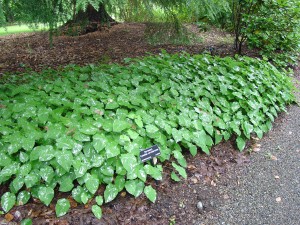Fairy wings, aka barrenwort (Epimedium spp.) thrive in shady spots. Fairy wings continue to be a plant collector’s dream. There are over 70 cultivars to choose and new hybrid selections coming along every year. No two cultivars are alike in flowering, foliage size and color. Species will vary from 6 to 20 inches in height and 10 to 24 inches in spread.
Fairy wings, depending on species, may be evergreen or deciduous. Seasonal leaf colors are also variable. Some begin chartreuse, turn dark green in summer, and finish in autumn shades of red. Others may develop a red or silvery tint in the summer.
Dainty flowers appear in early spring and are rarely hurt by cold morning temps. Flowering interval lasts 3, sometimes 4 weeks long and attract early arriving butterflies and hummingbirds. Deer don’t bother fairy wings.
Fairy wings grow in average soil. It may take 2-3 years for you to decide that fairy wings are for you. They start out slow. Provide them with a half day sunlight, preferably in the morning or in day-long partial shade. Feed slow-release fertilizer at planting and each spring; or feed monthly from spring to mid-August with a water-soluble plant food.
Clip back or mow over at 4-5 inch height setting in March as winter weather begins to moderate and before flowers appear. Removal of older foliage permits easier viewing of emerging flowers. Fairy wings have almost no pest or disease problems.
Fairy wings are excellent ground covers for planting under trees or fronting flower borders with the taller shade-loving perennials such as Lenten roses (Helleborus spp.), Variegated Solomon seal (Polygonatum), brunneras, astilbes, and ferns in the rear.
Thinking about starting a fairy wings collection? Start with these five:
Red barrenwort (E. × rubrum) – reddish summer semi-evergreen foliage; bicolor flowers.
E. perralderianum – yellow spring flowers; spiny-edged evergreen leaves, tinged red in the fall
Young’s barrenwort (E. × youngianum) – deciduous green spring foliage starts reddish green, green in summer, ending red in fall; pinkish white flowers.
‘Sulphureum’ barrenwort (E. × versicolor) – mottled red foliage becomes evergreen; primrose yellow flowers.
Longspur barrenwort (E. grandiflorum) – light green heart-shaped deciduous foliage; large white flowers.


 Posted in
Posted in 
